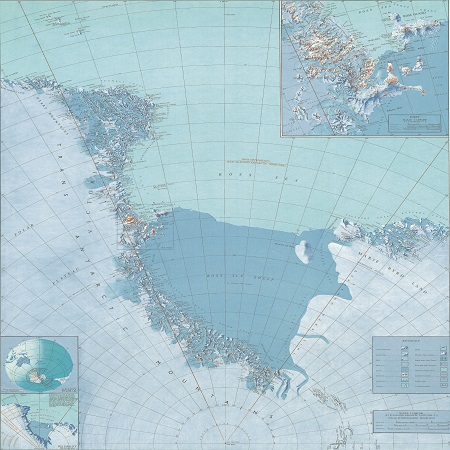In 1957, Scott Base was established by Sir Edmund Hillary to support the Commonwealth Trans-Antarctic Expedition and this became a permanent station for scientific research.
The Antarctic is fragile and unique. It makes up nearly 10% of the earth’s landmass and 98% of it is covered by ice. Many marine mammals and seabirds migrate between the rich feeding grounds that surround Antarctica and New Zealand. While the region remains largely unchanged by human intervention, the small number of visitors to Antarctica continues to increase, and there's international interest in ensuring that activities in the region are planned, safe and environmentally responsible.
Governance of a natural reserve
Several countries (Argentina, Australia, Chile, France, New Zealand, Norway and the UK) claim parts of the Antarctic as their own. Since 1923 New Zealand has maintained a right of sovereignty over the Ross Dependency, which was originally part of the UK’s claims in the Antarctic. The Ross Dependency includes the Ross Ice Shelf, the Balleny Islands, Scott Island and other adjacent islands.
Activities in Antarctica are governed by the Antarctic Treaty of 1959. This unique agreement among the claimant states and other countries commits them to using Antarctica for peaceful purposes only, sets aside the potential for disputes over territorial claims, and focuses on scientific research and sharing findings with the rest of the world.

New Zealand is also party to other agreements, which along with the Antarctic Treaty make up the Antarctic Treaty System. One of these agreements is the Protocol on Environmental Protection to the Antarctic Treaty, which designates Antarctica as a natural reserve, devoted to peace and science, prohibits mineral resource activities, and requires assessment of the environmental impacts of any human activities there.
New Zealand is also a member of the Commission for the Conservation of Antarctic Marine Living Resources (CCAMLR), which protects the Antarctic marine ecosystem while managing sustainable harvesting. In 2016, the 25 members of CCAMLR unanimously agreed to establish a Marine Protected Area in the Ross Sea region.
Find out more about:
New Zealand’s strategy for the Ross Sea
The Ross Sea region Marine Protected Area is part of our strategy for the precautionary and sustainable management of the flora, fauna, and broader environment in and around the Ross Sea. The strategy seeks to strike a balance between marine protection and sustainable harvesting that fits with CCAMLR’s conservation principles.
We’re also:
- Making a significant contribution to marine research and ecosystem monitoring.
- Helping to improve CCAMLR’s fisheries management.
- Fighting illegal, unreported and unregulated (IUU) fishing.
Our role within the region
We are the government agency responsible for New Zealand's overall interests in Antarctica and the Southern Ocean. Our main roles include:
- Pursuing New Zealand’s interests in the Antarctic Treaty System.
- Coordinating policy advice on Antarctica and the Southern Ocean, including the Ross Dependency.
- Conducting New Zealand's relations with other countries in respect of Antarctica.
- Coordinating New Zealand's maritime surveillance activities in the Southern Ocean.
We work closely with a range of government agencies and Antarctica New Zealand - the Crown Entity that manages Scott Base and is responsible for activities in Antarctica and the Southern Ocean such as scientific research, conservation, and public awareness.

